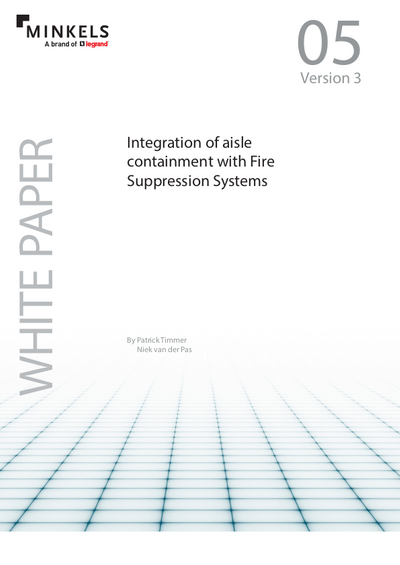Integration of aisle containment with Fire Suppression Systems
The Minkels White paper 05, Integration of aisle containment with Fire Suppression Systems, is one in a series of White papers sharing valuable data centre knowledge on managerial and technical levels.
The integration of aisle containment and fire safety systems
Aisle containment and fire detection & suppression systems interact with each other in a way that is not always understood very well. A data centre might find itself confronted with disapproval by insurance companies and AHJ's (authorities having jurisdiction) if:
- both subjects are not integrated from scratch
- a few basic principles are not followed
This is a waste of time and effort that can easily be avoided. Daily practice shows that a well-integrated design can always be made, no matter the type or size of data centre.
Different stakeholders and preferences
The complexity of fire safety design is partially related to the different stakeholders involved and their preferences:
- insurance companies have the tendency to focus on the building asset and the value of the infrastructure
- fire departments and other AHJ's focus on the safety of people and preservation of the building mainly
- data centre operators want to secure their business continuity and IT hardware.
In-time inventory of these different preferences guarantees a well-integrated design. Project delays will be avoided.
The integration of fire safety and cooling
The integration of fire safety and cooling is not so straightforward. The standards are mostly
dedicated to deal with the topics individually. Only the NFPA 75 (National Fire Protection Agency) currently addresses the impact of the aisle containment design on fire detection and suppression systems. According to the NFPA 75, aisle containment, curtains and hot collar systems are considered obstacles but the documentation does not exactly explain why. Nevertheless they provide guidelines on how to mitigate the effects of the obstruction and how to make sure that fire safety is not compromised. Insurance companies, on the other hand, can be more prescriptive in the type of solutions they want to see. In general, clean agent suppression is still considered the ideal solution for safeguarding IT processes while sprinkler systems are considered the best way to protect a building. The FM approved Drop Away Panels are approved by insurance companies to be used in conjunction with these sprinklers. The required solution depends on the context in which the IT room is located.
The type of extinguishing
The type of extinguishing, water or clean agent, affects the aisle containment design. In both situations one has to make sure that the spray patterns are effective in all cases. Values for clearance and coverage determine suppressant effectiveness. If an obstruction is too close, spray patterns are negatively influenced and not all locations can be reached. Other effects that especially take place with clean agent (gas) suppression are the pressure effects during suppression. One has to make sure that the pressure during suppression doesn't damage the infrastructure construction. By adding pressure relief vents combined with capacity sizing, pressures can be controlled and damage to construction and IT equipment can be prevented.
Four different applications of the aisle containment system
Conclusion: a well-integrated design between cooling and fire safety can be achieved when combining:
- an integrated approach in an early design stage
- a few basic principles
Four actual cases show a completely different application of the aisle containment system. Due to the fact that the fire detection and suppression is integrated with cooling early in the project, a wellintegrated design is achieved.




